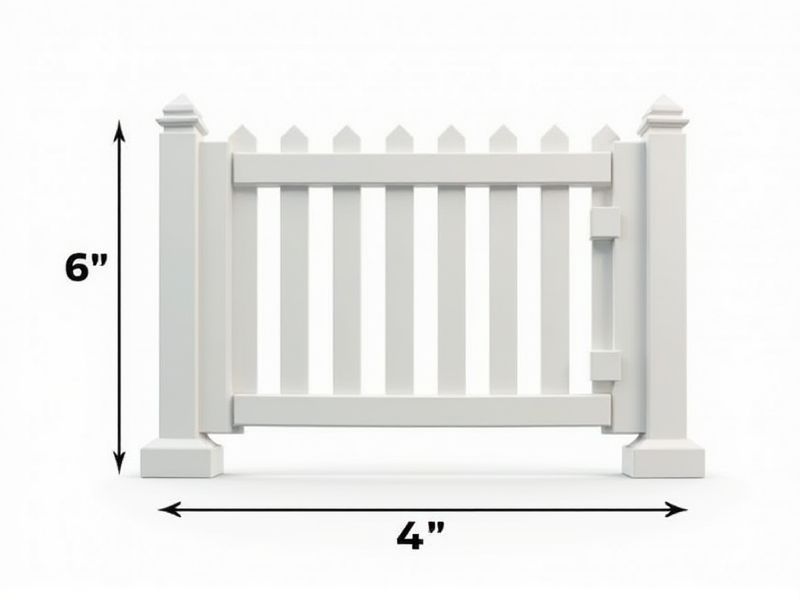
When planning a fence, understanding standard dimensions can save you time and ensure your project meets common requirements. Most residential fences range from 4 to 6 feet in height, with privacy fences typically being 6 feet tall. Fence posts are usually spaced 6 to 8 feet apart, depending on the material and design. Always remember to check your local building codes and neighborhood regulations, as these can impact allowable fence heights and placement.
Fence Height
The standard height for residential fences typically ranges from 4 to 6 feet, with local regulations often dictating specific limits. A 6-foot fence is generally recommended for privacy, while a 4-foot option can enhance visibility and security without obstructing views. In some neighborhoods, a maximum fence height can be 8 feet for certain materials such as wood or vinyl, especially if you're seeking added privacy from a busy street. When planning your fence installation, check local zoning laws to ensure compliance and avoid potential fines, as heights exceeding these standards may require permits or adjustments.
Post Spacing
Post spacing in fencing typically ranges from 6 to 8 feet apart, depending on the type of fence and its intended purpose. For a sturdy fence, it's advisable to use a spacing of around 6 feet, which provides enhanced stability and support against wind and pressure. In contrast, lighter decorative fences may allow for wider spacing, such as 8 feet, without compromising integrity. Ensuring proper post spacing is crucial for safety and longevity, impacting not only the overall appearance but also the functionality of your fence.
Panel Width
The standard fence panel width typically measures 6 feet, providing a balance between stability and aesthetic appeal for residential properties. Most manufacturers offer panels that vary in height, such as 3, 4, 5, or 6 feet, allowing you to choose based on your privacy and security preferences. A consistent panel width simplifies installation, as it aligns easily with standard post spacing of 8 feet. It's essential to consider local regulations, as some areas may have restrictions on height, which could affect your fence design decisions.
Board Thickness
When selecting a fence, the board thickness is a crucial factor that affects durability and aesthetic appeal. Typically, standard fence boards range from 0.5 to 1 inch in thickness, with thicker boards providing enhanced resistance to weather elements and physical wear. For instance, a 1-inch thick board can last significantly longer than a 0.5-inch board, making it a more cost-effective choice over time. Ensure that your chosen material, coupled with appropriate thickness, meets local building codes and will withstand the specific environmental conditions of your area.
Rail Distance
The standard rail distance for fencing typically measures 8 feet, which is crucial for ensuring structural integrity and proper spacing. This measurement allows for effective management of livestock or security perimeters while maintaining aesthetic appeal. The fence's material, such as wood or vinyl, can also influence durability, with pressure-treated lumber lasting up to 30 years. Ensuring proper installation techniques, including post depth of at least 2 feet, enhances the overall stability and longevity of your fence.
Gate Dimensions
The standard gate dimensions typically range from 3 to 4 feet in width and 6 to 8 feet in height, accommodating various residential and commercial applications. For optimum functionality, a double gate can span 6 to 12 feet wide and often includes a latch mechanism for secure closure. Your choice of gate materials, such as wood, vinyl, or wrought iron, significantly influences durability and aesthetics, with wood often requiring more maintenance. Consider compliance with local zoning regulations, which may dictate specific height and design standards for fences and gates in your area.
Slat Spacing
The standard slat spacing for fences typically ranges from 2 to 4 inches, ensuring both privacy and visibility. This adjustment allows for adequate airflow while maintaining aesthetic appeal. To comply with local regulations, it's important to check any specific spacing requirements, as they may vary by municipality or neighborhood. A well-planned spacing strategy can enhance the durability of your fence while providing the desired level of enclosure.
Ground Clearance
A standard fence typically requires a ground clearance of at least 4 to 6 inches to allow for proper drainage and prevent water accumulation. This height helps to minimize rot and deterioration, extending the lifespan of the fence materials. Maintaining adequate ground clearance also deters pests from burrowing under the fence, safeguarding your property from potential infestations. Ensuring this clearance during installation is crucial for enhancing both functionality and durability.
Anchor Depth
The standard for fence installation emphasizes the importance of anchor depth, which should ideally be at least 1/3 of the total fence height. For example, if your fence is 6 feet tall, the anchor should extend a minimum of 2 feet deep into the ground. This depth ensures proper stability and resistance against environmental factors such as wind and soil movement. Following these guidelines can significantly enhance the durability and longevity of your fence structure.
Material Specifications
Material specifications for fences typically include wood, vinyl, metal, and composite options, each providing unique benefits. For example, treated wood fences can last 15 to 20 years with proper maintenance, while vinyl options often have a lifespan exceeding 30 years. Metal fences, such as aluminum or wrought iron, offer durability and resistance to rust, with an average lifespan of over 50 years when galvanized. Your choice of material directly affects not only the fence's longevity but also its aesthetic appeal and maintenance requirements.
